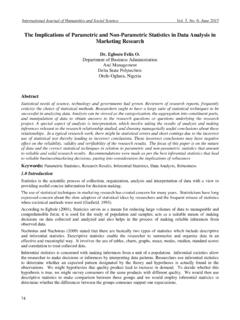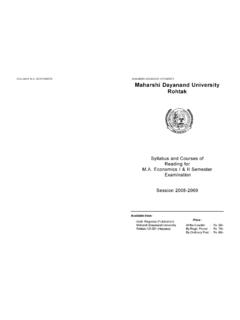Transcription of Assessment of EPCM as Critical Success Factor of ...
1 International Journal of Applied Science and Technology Vol. 2 No. 5; May 2012 66 A Case Study Approach to EPCM in Light of Construction Project Success in Malaysia Mr Wai, Soon Han Faculty of Civil Engineering University of Technology Malaysia 81300 Skudai, Johor Bahru Malaysia Ms Md Yusof, Aminah (PhD) Faculty of Civil Engineering University of Technology Malaysia 81300 Skudai, Johor Bahru Malaysia Ms Ismail, Syuhaida (PhD) Department of Civil Engineering University of Technology Malaysia International Campus Kuala Lumpur, Malaysia Abstract It is undoubtedly true that procurement methods are positively related to the Success of any construction project. As the construction industry expand rapidly, the need for a variety of procurement methods increases simultaneously.
2 Taking into account the dynamic nature of large industrial projects, a more flexible and effective procurement method is needed. To address the problem, Engineering, Procurement, Construction and Management (EPCM) is perceived as an alternative solution, though minimal works on the EPCM contract have been undertaken. Drawing from the analyses of data collected in case studies of EPCM construction projects, the results of this paper demonstrate that the EPCM contract is the ideal procurement method for warehouse projects with respect to the time, cost, and quality that a customer will demand. The limitation and future research directions related to the EPCM contract are also discussed in this paper.
3 Key words: construction industry, construction management, procurement, Malaysia 1. Introduction The dynamic nature of the construction industry necessitates an appropriate procurement model to ensure the overall Success of a project. A study conducted by Sanvido et al. (1992) and Phua (2004) considered project contracts, which encouraged various specialists to work as a team without conflicts, as a project Success Factor . A recent study conducted by Shokri-Ghasabeh and Kavousi-Chabok (2009) posited that contracts can be designed for a project to facilitate the project execution and help the management optimize the cost of the project. As the industry expands rapidly, traditional procurement methods have insufficiently addressed the changing nature of scope of construction projects.
4 Consequently, various procurement methods have emerged, including international joint venture (Adnan et al., 2011); Build, Operate, and Transfer (Tiong et al., 1992); and Engineering, Procurement, and Construction (EPC), more popularly known as the turnkey model. Of these procurement methods, international joint venture is vulnerable to disputes because it involves the joint venture of more than one country. _____ * The research was supported by the Grant for Research University (GUP) of the University of Technology Malaysia, Johor for research funding under Cost Centre No. The authors of this paper would like to acknowledge the valuable information provided by the EPCM consultant and assistance from Ministry of Higher Education (MOHE), University of Technology Malaysia (UTM), Research Management Center (RMC), and Innovative Construction Research Alliance (ICON) in making this paper a reality.
5 Centre for Promoting Ideas, USA .com 67 Traditional procurement methods have found to fail to satisfy owners needs, especially in addressing complex construction projects (Lam, 2000). Build, Operate and Transfer is less flexible, and if the EPC contractor is not willing to assume responsibility for basic engineering, an EPC contract is not an option at all (Loots and Henchie, 2007). The EPC contract covers all activities in three main phases, namely, design or engineering, procurement, and construction (PMI, 1997). EPC is a contracting method in which an EPC contractor is employed to perform the construction process from the design phase and, procurement to physically constructing the product.
6 It is not uncommon for an EPC contractor to partially outsource the scope of work of a project. EPC contract has reigned supreme because of its nature of bearing more risk in the project implementation process (Chen, 2009). Previous studies on EPC contracts have focused mainly on studying issues of risk (Qi et al.,2010; Wu et al., 2010; Guo et al., 2010; Gu et al., 2011), management (Ning and Teo, 2000; Mahmoud-Jouini et al., 2004; Carrillo, 2005; Hui and Qin, 2010), and information management (Moreau and Back, 2000; Wu et al., 2010). This paper raises concern over another contracting method namely Engineering, Procurement, Construction and Management (EPCM), an improvised version of EPC. Few studies that compare EPCM contracts have been performed.
7 Therefore, this paper specifically addresses the EPCM contract in light of construction project Success in Malaysia. The rationale of this paper holds that theoretical saturation occurs, whereby additional analysis no longer contributes to discovering anything new about a category (Locke, 2001) with particular regard to EPCM. Loots and Henchie (2007) echo this reasoning by explaining that not a single article about EPCM contracts was found;, only a list of EPCM contracts and EPCM contractors was found by searching Google. Thus, there is a need for the author to address this research gap. This paper aims to go one step further by addressing a research question that is emerged from the data.
8 The question regards how EPCM can be considered an ideal option for delivering construction projects. The research question immediately leads to another question about how to assess the Success of a construction project to further qualify the EPCM as an ideal option. The overall objective of this paper is to provide justification to the questions. Therefore, the literature review in the subsequent section covers EPCM and the notion of construction project Success . 2. Literature Review Engineering, Procurement, Construction, and Management (EPCM) The exact origin of EPCM cannot be traced. The idea emerged in the mining sector and has more recently become prevalent in the construction industry, particular in respect to international infrastructure and major construction works (Loots and Henchie, 2007).
9 The EPCM model differs from the EPC model in that it does not feature the concept of sole responsibility for a project, substitutes a single contractor (the Engineer) to design the project and calls for others (suppliers and contractors) to equip and construct it (Charles, 2009). In other words, the unique characteristic of EPCM is that a third party will be employed to build the product with the consent of the owner. The EPCM contractor will only supervise and manage the process of construction process. Charles (2009) has drawn ten points of comparison between EPC and EPCM, which includes cost and schedule, defective work versus defective services, intellectual property, change of orders and changes to the contract, standards for performance, termination or suspension of rights, insurance and indemnification, dispute resolution and governing law, liability limits and security of tenure.
10 The study is conducted from the owner s perspective. As such, the study benefits owners in formulating the ultimate EPCM agreement. From the study, one may easily point out that EPCM is a more flexible contracting method compared to EPC because it involves the client in the execution of a project. On the other hand, it is also more risky because the consultant is not suited for a timely and cost-effective project. Beddoes et al. (2009) reported a case study on the Dampier Port Upgrade project, which is the largest project in Rio Tinto Iron Ore s expansion program. They found that EPCM is a flexible model that is specially suited to upgrade project, which require new facilities to be constructed without major disruption to the existing operation.






